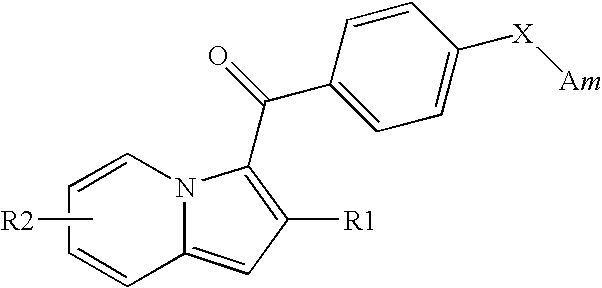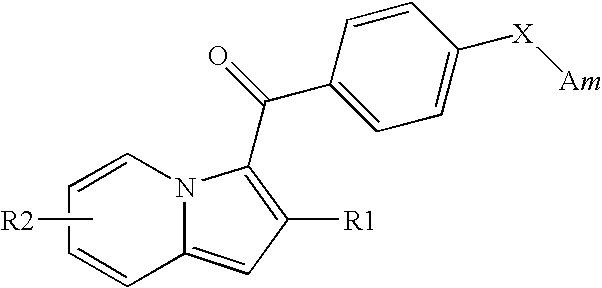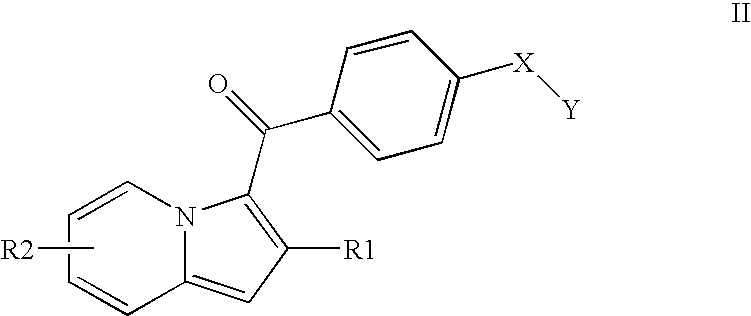Indolizine derivatives, method for preparing same, and therapeutic compositions comprising same
a technology of indolizine and derivatives, which is applied in the field of indolizine derivatives, can solve the problems of limited the possibility of preparing and storing in the form of injectable substances, insoluble or only slightly soluble compounds in water, and limit the possibility of preparing and storing, so as to inhibit the permeability of human herg
- Summary
- Abstract
- Description
- Claims
- Application Information
AI Technical Summary
Benefits of technology
Problems solved by technology
Method used
Image
Examples
example 1
(2-butyl-6-ethylindolizin-3-yl){4-[3-(dipropylamino)propyl]phenyl}methanone hydrochloride (compound 44)
a) 1-bromohexane-2-one
[0081]60 g (0.599 mole) of 2-hexanone was slowly added to a solution of 58.6 g (0.976 mole) of urea in 210 ml of acetic acid at ambient temperature. The medium was cooled to 0° C. in an ice bath then 33 ml of bromine (0.640 mole) was added and it was stirred for 18 hours at ambient temperature. It was poured onto water (1500 ml) and extracted with methylene chloride, the organic phase was washed with a sodium bicarbonate solution, then dried over sodium sulphate and the solution was concentrated.
[0082]The residue was distilled under reduced pressure. 76 g of the expected compound was recovered (boiling point: 80-90° C. / 18 mmHg), contaminated with a little of its isomer, 3-bromohexanone (6%).
b) N-(hexanone-2-yl)-2-methyl-5-ethylpyridinium bromide
[0083]21.6 g (0.178 mole) of 5-ethyl-2-methylpyridine was added slowly to 40 g of 1-bromo-2-hexanone (0.223 mole) and...
example 2
(2-ethylindolizin-3-yl){4-[3-(diethylamino)propyl]phenyl}methanone oxalate (compound 2)
a) (2-ethylindolizin-3-yl)[4-(3-chloropropyl)phenyl]methanone
[0101]A mixture of 8 g (55 mmoles) of 2-ethyl-indolizine and 13.1 g (60 mmoles) of 4-(3-chloropropyl)benzoyl chloride was heated to 50° C. for 18 hours. It was taken up in water, extracted with dichloromethane, washed with a sodium carbonate solution; the organic phase was then dried over sodium sulphate and concentrated to dryness. It was purified by flash chromatography over alumina (eluent: cyclohexane / methylene chloride, 50 / 50). In this manner, 17 g of the desired compound was obtained in the form of an oil. Yield: 94%.
b) (2-ethylindolizin-3-yl){4-[3-(diethylamino)propyl]phenyl}methanone
[0102]4 g (12 mmoles) of the compound obtained in the preceding step was dissolved in 50 ml of methyl isobutylketone in a reactor then 2.3 g (31 mmoles) of diethylamine and 0.36 g (2.4 mmoles) of sodium iodide were added to that medium and heated to 1...
example 3
(2-butylindolizin-3-yl){4-[3-(dipropylamino)propyl]phenyl}methanone hydrochloride (compound 7)
a) 2-methyl-1-(2-oxo-hexyl)-pyridinium bromide
[0107]30.21 g of 2-picoline (0.32 mole) was slowly added to 83 g of 1-bromo-2-hexanone (0.46 mole) and stirred for 4 hours at ambient temperature. A viscous medium was obtained which was used as is for the next step.
b) 2-butylindolizine
[0108]The N-(hexanone-2-yl)methyl-pyridinium bromide obtained above was dissolved in 100 ml of ethanol and 84 g of sodium bicarbonate in solution in 630 ml of water was added. The reaction medium was heated for 3 h at 110° C. It was vacuum concentrated, taken up in water, extracted with dichloromethane, the organic phase was washed with a sodium chloride solution, dried over sodium sulphate and evaporated to dryness. The product obtained was purified on a silica column under pressure (eluent: methylene chloride / heptane, 20 / 80). In this manner, 33 g of 2-butylindolizine was obtained.
[0109]Yield: 30%
c) 2-butylindoli...
PUM
| Property | Measurement | Unit |
|---|---|---|
| pH | aaaaa | aaaaa |
| weight | aaaaa | aaaaa |
| weight | aaaaa | aaaaa |
Abstract
Description
Claims
Application Information
 Login to View More
Login to View More - R&D
- Intellectual Property
- Life Sciences
- Materials
- Tech Scout
- Unparalleled Data Quality
- Higher Quality Content
- 60% Fewer Hallucinations
Browse by: Latest US Patents, China's latest patents, Technical Efficacy Thesaurus, Application Domain, Technology Topic, Popular Technical Reports.
© 2025 PatSnap. All rights reserved.Legal|Privacy policy|Modern Slavery Act Transparency Statement|Sitemap|About US| Contact US: help@patsnap.com



